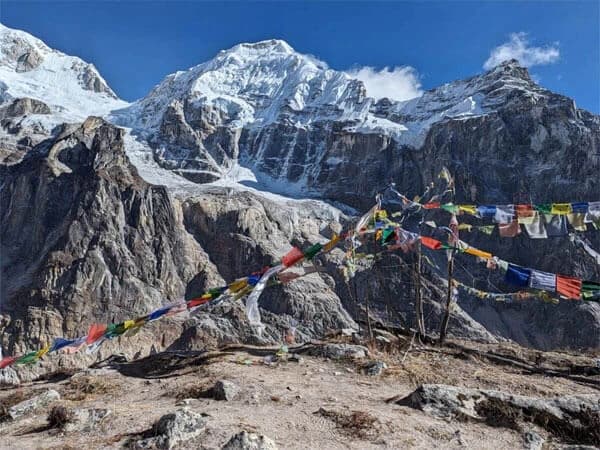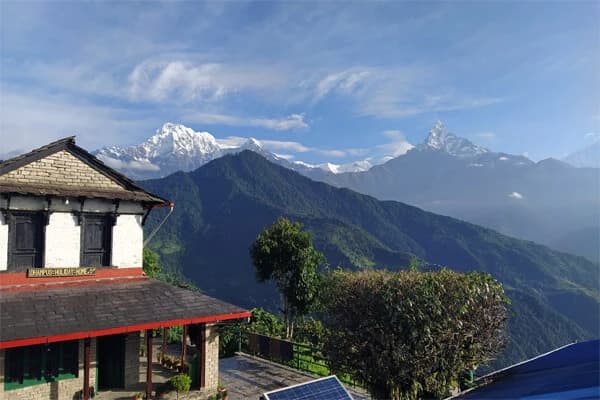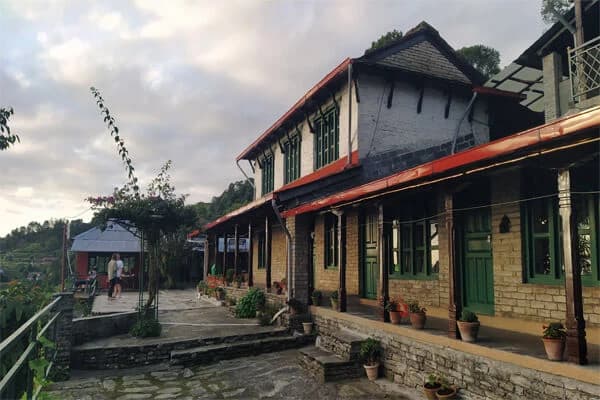The best time for the Kanchenjunga Base Camp Trek is spring (March–May) and autumn (September–November) when the weather is stable, and the views are stunning. Spring offers colorful rhododendron blooms, while autumn provides clear skies and excellent visibility. Monsoon (June–August) brings heavy rain, making trails slippery, and winter (December–February) can be extremely cold, making trekking more difficult.
Best Time for Kanchenjunga Base Camp Trek
The best time for Kanchenjunga base camp trek is spring and autumn. During this month all the weather is stable and skies are always clear as well as mountain views are breathtaking. Spring bring vibrant rhododerdron bloom while autumn offers crisp air and excellent visibility
The Kanchenjunga Base Camp Trek offers an unparalleled journey through some of Nepal's most majestic landscapes, culminating in a breathtaking close-up view of the world's third-highest peak, Mt. Kanchenjunga. This remote trek is not just about the challenging paths or the stunning scenery; it’s a gateway to experiencing the region's rich biodiversity and vibrant culture. Selecting the best time to trek is crucial for maximizing the experience, whether you seek clear mountain views or the comfort of pleasant weather.
Understanding the optimal seasons for trekking to Kanchenjunga is essential for planning your adventure. The region’s weather patterns dictate not just the feasibility of the trek, but also what you will be able to see and experience. While each season offers unique insights and experiences, the pre-monsoon spring months and the post-monsoon autumn period are particularly favorable. These times feature the most stable weather conditions, offering clearer skies and more accessible trails, making them the best time for Kanchenjunga Base Camp trek. So Spring and Autmn offer best season for kanchenjunga trekking. Here we describe season wise detail information for trekking to kanchenjunga base camp.
Kanchenjunga Base Camp Trek in Spring (March to May)
Spring is one of the most popular seasons for the Kanchenjunga Base Camp Trek, offering a perfect blend of favorable weather and stunning natural beauty.
- Kanchenjunga base camp trek Weather: The weather during spring is generally stable, making it an ideal time for trekking. As you ascend, you’ll experience warmer temperatures, a welcome change from the colder winter months. The skies are typically clear, allowing for uninterrupted trekking and fewer weather-related disruptions. So Spring is the best weather for Kanchenjunga base camp trek.
- Flora and Fauna: Spring is a paradise for nature lovers. The trails are lined with vibrant rhododendrons, magnolias, and other wildflowers in full bloom. This burst of color creates a picturesque environment and adds to the overall enjoyment of the trek. The lush greenery and fragrant blooms make the landscape come alive, providing ample photography and nature observation opportunities.
- Views: Visibility is at its best during spring. The clear skies offer stunning, unobstructed views of Kanchenjunga and the surrounding peaks. This is the perfect time to capture panoramic shots and fully appreciate the grandeur of the Himalayas. The excellent visibility ensures that trekkers can enjoy the breathtaking scenery throughout their journey.
Highlights of Spring trekking in Kanchenjunga:
- Pleasant temperatures: Comfortable trekking conditions with warmer temperatures as you climb higher.
- Blooming flowers and lush greenery: A vibrant and colorful trekking environment with flowers in full bloom.
- Clear mountain views: Excellent visibility, offering stunning and unobstructed views of Kanchenjunga and the surrounding peaks.
Spring is an exceptional time for the Kanchenjunga Base Camp Trek, providing a perfect combination of pleasant weather, vibrant natural beauty, and breathtaking mountain views.
Kanchenjunga Base Camp Trek in Autumn Season (September to November)
Autumn is another prime season for the Kanchenjunga Base Camp Trek, offering trekkers stable weather and some of the clearest views of the year.
- Kanchenjunga base camp trek Weather: The post-monsoon period brings stable and dry weather conditions, making it one of the best times for trekking in the Kanchenjunga region. Temperatures are cool and pleasant, providing comfortable trekking conditions. The risk of rain is minimal, ensuring that trails are in good condition and safer for trekking. So Autumn is the best weather for Kanchenjunga base camp trek.
- Views: Autumn offers some of the clearest and most breathtaking mountain views. The skies are crisp and clear, providing unobstructed vistas of Kanchenjunga and its neighboring peaks. This season is ideal for photography, with the sharp clarity of the mountain landscapes offering spectacular photo opportunities.
- Kanchenjunga base camp trekking Trail Conditions: The trails are in their best condition during autumn, having been cleared and settled after the monsoon rains. This makes for a more enjoyable and safer trekking experience. Additionally, the lower risk of landslides and other trail-related issues makes autumn a preferred season for many trekkers.
Highlights of Autumn trekking in Kanchenjunga:
- Stable and dry weather: Ideal trekking conditions with minimal risk of rain and clear skies.
- Excellent visibility: Crystal-clear views of Kanchenjunga and the surrounding peaks, perfect for photography and mountain viewing.
- Comfortable temperatures: Cool and pleasant weather, making for a more enjoyable trekking experience.
Autumn is an excellent time for the Kanchenjunga Base Camp Trek, providing a perfect combination of stable weather, clear views, and optimal trail conditions. This season ensures a memorable and rewarding trekking adventure in the Himalayas.
As per given informanton that best seasons for Kanchenjunga trek in spring and autumn. Spring offers blooming rhododendrons lush forests and modrated temparature making the trail vibrant. Autumn is the best season to see crystal-clear skies and picturesque mountain view and stable weather. Nepal Trekking Routes ensuring an enjoyable trekking experience in this both season. There are fewer weather related challenges we face during this time
Kanchenjunga Base Camp Trek in Monsoon Season (June to August)
The monsoon season is a unique time to undertake the Kanchenjunga Base Camp Trek, characterized by lush greenery and fewer trekkers on the trails. However, it also presents significant challenges that trekkers need to consider.
- Kanchenjunga Base Camp Trek Weather: The monsoon season brings heavy rainfall to the Kanchenjunga region. This period is marked by frequent showers, high humidity, and cloudy skies. The rain can be persistent, leading to wet and muddy trails, which can make trekking more difficult and potentially hazardous.
- Kanchenjunga Base Camp Trekking Trail Conditions: The heavy rainfall can cause the trails to become slippery and muddy, increasing the risk of falls and injuries. Landslides are also a concern during this season, which can obstruct paths and create dangerous trekking conditions. Additionally, river crossings can become more challenging due to higher water levels.
- Flora and Fauna: Despite the challenges, the monsoon season has its beauty. The rainfall transforms the landscape into a lush, green paradise. The forests are dense and vibrant, with waterfalls and streams flowing abundantly. This season is a treat for nature lovers who appreciate the rich biodiversity and the sight of various plants and flowers in full bloom.
- Views: The views during the monsoon season can be hit or miss. The cloud cover can obscure the mountain peaks, making it difficult to get clear views of Kanchenjunga and its surroundings. However, there are moments when the clouds part, revealing breathtaking, misty landscapes that are uniquely beautiful.
Highlights of Monsoon season trekking in Kanchenjunga region:
- Lush green landscapes: The rain brings the forests and meadows to life, creating a vibrant and verdant trekking environment.
- Fewer trekkers: The trails are less crowded, providing a more solitary and peaceful trekking experience.
- Rich biodiversity: The monsoon season is ideal for observing the region's flora and fauna in their full splendor.
While the monsoon season offers a unique and serene trekking experience with lush green landscapes and rich biodiversity, it also presents significant challenges such as slippery trails and potential landslides. Trekkers who choose this season should be prepared for adverse conditions and take necessary precautions to ensure a safe and enjoyable journey.
Kanchenjunga Base Camp Trek in Winter Season (December to February)
The winter season offers a unique and challenging experience for those embarking on the Kanchenjunga Base Camp Trek. This period is characterized by extreme cold, snow-covered landscapes, and fewer trekkers on the trails.
- Kanchenjunga Base Camp Trekking Weather: Winter in the Kanchenjunga region is harsh, with temperatures dropping significantly, especially at higher altitudes. Daytime temperatures can be bearable, but nighttime temperatures often plummet below freezing. The cold can be intense, and heavy snowfall is common, which can impact trail accessibility.
- Kanchenjunga Base Camp Trekking Trail Conditions: The trails during winter are often covered in snow, making trekking more difficult. Certain sections of the trek may be impassable due to deep snow or ice, requiring trekkers to have experience with winter trekking and proper gear. The risks of frostbite and hypothermia are higher, necessitating careful planning and preparation.
- Flora and Fauna: Winter brings a stark beauty to the Kanchenjunga region. The lush greenery of other seasons gives way to a serene, snow-covered landscape. Wildlife sightings become rare as many animals go into hibernation or migrate to lower altitudes. However, the tranquil and pristine environment offers a different kind of natural beauty.
- Views: The views during winter are breathtaking, with clear skies often providing sharp, unobstructed vistas of the snow-capped peaks. The landscape, blanketed in snow, offers stunning contrasts and a sense of untouched wilderness. Photographers will find the winter scenery incredibly rewarding, with crisp and clear conditions perfect for capturing the majestic Himalayas.
Highlights of Winter season trekking in Kanchenjunga:
- Stunning snow-covered landscapes: The winter scenery is unparalleled, with snow-capped mountains and pristine, white surroundings.
- Fewer trekkers: The trails are much less crowded, providing a peaceful and solitary trekking experience.
- Clear skies and sharp views: The cold, dry air can lead to excellent visibility and some of the best mountain views of the year.
Winter trekking in Kanchenjunga base camp is challenging due to the extreme cold and snow-covered trails, it also offers a unique and rewarding experience. Trekkers who are well-prepared for the harsh conditions can enjoy the serene beauty and solitude of the Himalayas in winter, making it an unforgettable adventure.
Here is the Ultimate Guide to Kanchenjunga Base Camp Trek
Key Considerations for the Kanchenjunga Base Camp Trek
The Kanchenjunga Base Camp Trek requires thorough preparation and an understanding of various factors to ensure a safe and enjoyable journey. Here are some key considerations to keep in mind:
Kanchenjunga Base Camp Trek Permits and Regulations
- Kanchenjunga Conservation Area Permit(KCAP): This permit is mandatory for all trekkers entering the Kanchenjunga Conservation Area.
- Restricted Area Permit (RAP): Required due to the proximity to the Nepal-India border, this permit ensures controlled access to the region.
- Trekkers’ Information Management System (TIMS) Card: Necessary for tracking and ensuring the safety of trekkers.
Kanchenjunga Base Camp Trekking Physical Fitness and Training
- Endurance and Stamina: The trek is demanding, with long hours of walking on challenging terrain. Regular cardio workouts, hiking, and strength training are essential to build endurance.
- Altitude Training: Acclimatization to high altitudes is crucial to prevent altitude sickness. Consider spending time at high altitudes or using a high-altitude training mask before the trek.
Acclimatization and Health
- Gradual Ascent: Plan your itinerary to include acclimatization days. A gradual ascent allows your body to adjust to the altitude and reduces the risk of altitude sickness.
- Hydration and Nutrition: Staying well-hydrated and consuming a balanced diet rich in carbohydrates and proteins is vital for maintaining energy levels.
Packing List
- Clothing: Layered clothing for varying temperatures, including thermal wear, fleece jackets, down jackets, waterproof jackets, and pants.
- Footwear: Sturdy, waterproof trekking boots with good ankle support. Bring extra pairs of warm socks.
- Gear: A quality backpack, trekking poles, a sleeping bag rated for low temperatures, and a headlamp with extra batteries.
- Accessories: Sunglasses, sunscreen, lip balm, gloves, a hat, and a buff or scarf for wind protection.
Safety and Emergency Preparedness
- First Aid Kit: Include basic first aid supplies, altitude sickness medication, blister treatment, and personal medications.
- Emergency Contacts: Keep a list of emergency contacts, including local authorities, your trekking agency, and the nearest medical facilities.
- Insurance: Comprehensive travel insurance that covers high-altitude trekking, emergency evacuation, and medical expenses is essential.
Local Culture and Etiquette
- Respect for Local Traditions: The Kanchenjunga region is home to diverse ethnic groups with unique customs and traditions. Show respect and follow local etiquette.
- Environmental Responsibility: Practice Leave No Trace principles. Dispose of waste properly and avoid using single-use plastics.
Guides and Porters for Kanchenjunga Base Camp Trek
- Hiring Professionals: Experienced guides and porters enhance your trekking experience by providing local knowledge, logistical support, and assistance with carrying heavy loads.
- Fair Compensation: Ensure fair wages and working conditions for guides and porters. Consider the weight limits for porters to prevent overloading.
Proper preparation and consideration of these key factors are essential for a successful Kanchenjunga Base Camp Trek. From securing the necessary permits and building physical fitness to packing appropriately and respecting local culture, thorough planning ensures a safe, enjoyable, and memorable adventure in the majestic Himalayas.
Kanchenjunga Base Camp Trek is an extraordinary adventure that requires meticulous planning and preparation. Understanding the best seasons for trekking, obtaining the necessary permits, building physical fitness, and packing appropriately are crucial steps in ensuring a safe and memorable journey. Additionally, respecting local culture and practicing environmental responsibility enriches the experience, allowing trekkers to fully appreciate the majestic beauty and diverse landscapes of the Kanchenjunga region. Whether you choose the blooming vibrancy of spring, the clear vistas of autumn, the lush greenery of the monsoon, or the serene snow-covered landscapes of winter, each season offers its unique charm and challenges. By considering these key factors and preparing thoroughly, trekkers can embark on a rewarding and unforgettable adventure to one of the world's most spectacular trekking destinations.
Trekking Condition of Kanchenjunga Base Camp Trek
Hiking to Kanchenjunga Base Camp offers a unique and challenging adventure through one of the most remote regions of the Himalayas. The trek typically spans around three weeks, navigating through diverse terrains from dense forests to rugged mountain passes. You'll experience both the North and South Base Camps, each presenting distinct landscapes and panoramic views of Kanchenjunga’s imposing peaks.
The journey is demanding, with long daily hikes and altitudes exceeding 5,000 meters, requiring solid physical preparation and acclimatization to avoid altitude sickness. Weather conditions can be unpredictable, varying drastically with altitude and time of day. Accommodations are basic, ranging from simple teahouses to occasional camping in more isolated areas, adding to the trek's adventurous spirit.
Given the trek's length and the lack of facilities, it's essential to go with an experienced guide who can navigate the challenging paths and manage logistics efficiently. Additionally, trekkers need to secure several permits due to the area's proximity to the Indian border. Despite its challenges, trekking to Kanchenjunga Base Camp is an immensely rewarding experience, offering a deep connection with nature and a true sense of achievement upon reaching the secluded North and South Base Camps.
Kanchenjunga base camp trekking tips
Trekking to Kanchenjunga Base Camp is a remote and challenging adventure. It calls for careful planning and preparation. Here are some essential tips to make your trek safe and enjoyable.
Physical Preparation
Train at least 2-3 months before the trek with cardio, strength training, and hiking practice. Stair climbing, lunges, and squats can all help increase leg endurance.
Acclimatization and Altitude Sickness Prevention
Ascend gradually, taking breaks at Ghunsa and Lhonak. To lower the risk of altitude sickness, drink plenty of water, avoid alcohol, and climb gradually. Carry altitude sickness medication, if necessary.
Essential Packing List
Wear layers, a warm down jacket, and waterproof gear for unpredictable weather. Use high-quality trekking boots and break them in before the trek.
Hire a Guide & Porter
A licensed guide is necessary as Kanchenjunga is a restricted area. For safety, permits, and logistics, book your trek with a reliable trekking agency.
Choose Ideal trekking season
The best seasons for weather and vistas are spring (March-May) and autumn (September-November).
If you prepare well, you can have an enjoyable and safe trip to Kanchenjunga Base Camp.
Kanchenjunga base camp trekking difficulties
The Kanchenjunga Base Camp is one of Nepal’s most difficult treks. The location of this trek is remote with high altitude and difficult terrain. Here are the challenges faced by the trekkers:
High Altitude and Acclimatization
The trek reaches over 5,000m at Pangpema, increasing the risk of altitude sickness. Proper acclimatization days in Ghunsa and Lhonak are crucial.
Long Duration and Physical Demand
The trek has a long duration of 14-20 days. It requires 5-7 hours of trekking daily over rough trails. The steep ascents, descents, and high passes add to the difficulty of the trek. It requires good endurance and fitness.
Remote and Limited Facilities
There are fewer teahouses and lodges along the route than other popular routes. The trekkers must bring extra snacks, warm clothing, and sleeping bags for comfort.
Weather Challenges
Rain, snow, and extremely cold temperatures are possible due to unpredictable weather. The best times for trekking are spring (March-May) and autumn (September-November).
Mandatory Guide and Permits
Hiring a certified guide from a trekking agency is necessary. Solo trekking is not allowed.
You can learn more about the difficulty of Kanchenjunga Base Camp Trek in our blog: How difficult is the Kanchenjunga Base Camp Trek?
The challenges of this trek can be overcome with proper preparation, training, and acclimatization.
Kanchenjunga Base Camp trek in October vs. April
October and April are both among the greatest times of year for the Kanchenjunga Base Camp Trek. However, they provide somewhat different experiences.
Trekking in October (Autumn Season)
- October offers best weather and clear views. The stable conditions with blue skies and clean air make it a perfect time to trek.
- The temperature is mild, ranging from 10 to 15°C during the day. During night, it drops to -5°C or lower at high altitudes.
- Due to the peak trekking season, more people are trekking. Teahouses are more readily available, but the demand is higher.
- The freshness of the post-monsoon season makes the trails greener and rivers fuller.
Trekking in April (Spring Season)
- The weather condition is pleasant. The temperatures are similar to October but little warmer at night.
- There are vibrant Rhododendron blooms and lush greenery along the trail.
- There are less trekkers than in October, offering a quieter experience.
- Winter snow may still be present in higher altitude areas.
Which month to choose?
You can choose October for stable weather and clear mountain views. Whereas, April is the right choice for blooming landscapes and fewer crowds.
Both months offer excellent trekking conditions. Choose the month according to your preferences.
Kanchenjunga trek best months for clear mountain views
The best months for clear mountain views on the Kanchenjunga Trek are October-November (Autumn) and April-November (Spring).
Autumn (October-November)
- Crystal-clear skies with excellent visibility of Kanchenjunga and the surrounding peaks.
- Stable weather with mild temperatures ranging 10-15°C in the day and colder at night.
- Post-monsoon freshness enhances the beauty of the landscapes.
Spring (April-May)
- Mornings are clear with occasional clouds.
- The trail is adorned by the vibrant colors of blooming rhododendron.
- Cooler temperatures and less wind than in autumn.
October and November are the best months for unobstructed views of the mountains.
FAQs of the Best Time for Kanchenjunga Base Camp Trek
What are the best months to trek to Kanchenjunga Base Camp?
The optimal months for the Kanchenjunga Base Camp Trek are during the spring (March to May) and autumn (September to November). These months feature the most stable weather conditions, clear skies, and moderate temperatures, making the trekking experience both enjoyable and safer.
Is it possible to trek to Kanchenjunga Base Camp during the monsoon season?
Trekking during the monsoon season (June to August) is possible but not recommended due to heavy rainfall, which can lead to slippery trails, increased risks of landslides, and poor visibility. Moreover, leeches are common during this time, which can be a nuisance.
Can I trek to Kanchenjunga Base Camp in winter?
Winter trekking (December to February) is challenging due to cold temperatures, snow-covered paths, and the potential closure of some lodges. However, for well-prepared and experienced trekkers, it offers a unique and tranquil experience with fewer crowds and stunning snowy landscapes.
What are the advantages of trekking in the recommended seasons?
Trekking in spring and autumn offers several advantages: vibrant natural scenery with blooming flowers in spring or changing leaves in autumn, optimal weather conditions with less rainfall and clearer skies for better views of the mountains, and more active wildlife.
Are the trails crowded during the peak trekking seasons?
While spring and autumn are the more popular trekking seasons, the trails to Kanchenjunga are generally less crowded than those to more frequented destinations like Everest or Annapurna. This allows for a more solitary and intimate trekking experience.
What should I prepare for trekking during the optimal seasons?
Preparation should include proper acclimatization to handle high altitudes, packing the right gear for variable temperatures, and planning for occasional rain showers, especially towards the end of the spring or the start of autumn. Additionally, securing all necessary permits in advance is crucial due to the trek's proximity to sensitive border areas.
What is the weather like in Kanchenjunga trek?
The weather on the Kanchenjunga trek is varies. Spring (March-May) offers mild temperatures with blooming rhododendrons. Autumn (September-November) has stable and clear weather. Winter (December-February) is extremely cold, and monsoon (June-August) brings heavy rain and landslides.
Winter trekking in Kanchenjunga – Is it possible?
Yes, winter trekking in Kanchenjunga is possible. However, it is very difficult because of the heavy snowfall, freezing weather, and limited availability of teahouse.
Conclusion: Best Time for Kanchenjunga Base Camp Trek
When planning your Kanchenjunga Base Camp Trek, choosing the right trekking company is just as important as picking the best time to trek. Nepal Trekking Routes has long been trusted by trekkers for offering well-organized, safe, and enjoyable treks to one of Nepal's most stunning and challenging destinations. Our expert guides and well-crafted itineraries ensure that you experience the best of what Kanchenjunga has to offer, during the most ideal trekking seasons. Join us to make your Himalayan adventure both memorable and spectacular.






